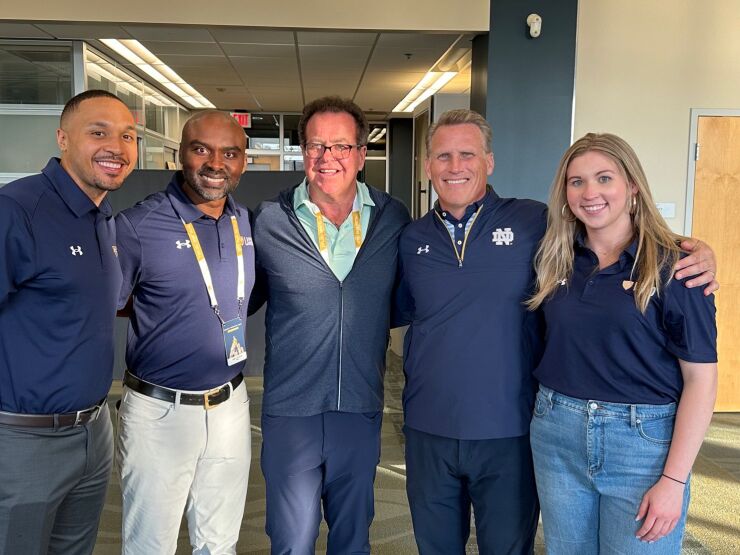Former University of Notre Dame Fighting Irish football stars are trying to tackle the health and financial problems that often afflict ex-athletes after their college playing days.
Many financial advisors view athletes as an important potential niche of clients. Among the many issues
A dozen former Irish football players have died by suicide in the past 10 years, according to Tom Carter, a one-time Notre Dame safety who played eight seasons in the National Football League and later spent 15 years as a director at the NFL Players Association. Another ex-Irish player who's chairman of a
"There's no silver bullet," Carter said in an interview, describing Life After Notre Dame as a "comprehensive plan" that gives "a fighting chance" to ex-athletes of any sport. "We wanted to be the first university in the country to offer our former athletes these benefits and services," he added.
Carter,
Organizers like Shields and Eilers, who after playing for Head Coach Lou Holtz as part of the 1988 national championship team and time in the NFL became a managing director at BlackRock and started a sustainable energy investment management firm called
"To our knowledge, there's nobody out there who has something as comprehensive as we do," Curry said. "That's why we hope to get it right and scale it nationally, because every school could benefit from this. There are so many athletes out there who need help."
A common problem
The program's goals rang true to other former National Collegiate Athletic Association athletes and wealth management executives familiar with the client niche. The team camaraderie and crowds of students, boosters and fans who "want to be around you because you're a top athlete" vanish quickly when a player's career is over, according to SaVion Harris, a former safety
Athletes should "actively and proactively" ask for career advice from mentors around their athletic programs who care about them and represent the type of "people you aspire to be," Harris said. "Finding your own identity" off the field and developing new routines in place of the strictly-regimented and time-consuming schedule of playing for an NCAA team are two of the biggest challenges facing athletes as they make the transition to a new career, he said.
"No matter what you do, it's never going to be the same as athletics," Harris said. "When you get out of that, now you have to find your own routine."
Unfortunately, many athletes "have never really had any mentorship or any types of services that would help them identify other aspirations or interests," according to Frederick Blue, the head of the high net worth segment in Wells Fargo's Wealth and Investment Management unit.
Wells Fargo Advisors announced its
Life After Notre Dame shows a "fantastic" approach to easing the player's adjustments into their post-athletic days, Blue said.
"It really has to be a coalition of partners that help these athletes transition to second careers. For many of them, their whole life has been centered around competitive sports," Blue said. "It's more difficult to make a transition."
LAND's services
The vast majority of NCAA athletes will navigate those changes without ever reaching the professional level in sports. Like
Life After Notre Dame's benefits for the ex-athletes consist of: "1:1 career coaching, resume building, mock interviews, goal assessments, and professional profile curation"; "innovation and entrepreneurship training" ; mental health services such as "immediate access" to "telepsychiatry, in-person rehabilitation clinics and an online education platform" ; "one of the nation's top virtual physical therapy networks, a leading inpatient rehabilitation hospital and a high-quality national network of vetted musculoskeletal care providers" ; and "emergency assistance through a needs-based, relief mechanism available to qualifying individuals having difficulty paying daily living expenses," Carter said
"We say to former student-athletes and student-managers who may be uncertain that Project LAND can help them: our services are designed to meet individual needs and goals," Carter wrote. "Some may need to top off the tank and continue flying. Others may need a more comprehensive program, and not just when they first transition from sports, but if needed, throughout their lives. That's our 4-for-40 commitment."









